The Deceptive Layouts of the Haze and Beardsley Households in Lolita, How the Deception Occurs, and When We are Awakened to the Deception

Go to TOC for this film ( (which has also a statement on purpose and manner of analysis and a disclaimer as to caveat emptor and my knowing anything authoritatively, which I do not, but I do try to not know earnestly, with some discretion, and considerable thought).
We are given two good views of the front of the Haze household.
Here is how we viewed the house when Humbert arrives in shot 71.

Below is how we see it in shot 180, when Lolita is leaving for camp.
It is obvious from these shots there is no lawn to the left (our left); instead there is a garage-like structure that appears as though it should belong to an unseen neighboring house to the left. Also obvious is a full second floor.
Below is approximately more how the house is, as we shall soon see, and it's doubtful there is a third floor as Humbert's room, though on the second floor, is the dormer shape of the third floor. As a matter of fact, so is Lolita's room a dormer.
The below image, not to scale, vaguely lays out how Kubrick structures our experience of the house. What we believe we are seeing. The lawn is to the rear of the house beyond the dining room.
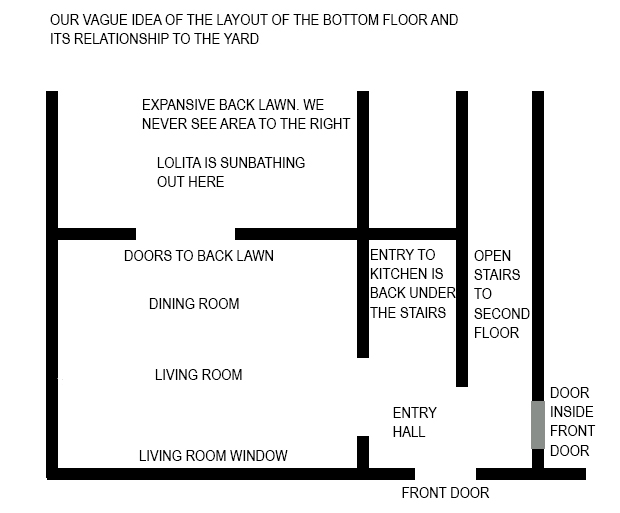
The below image, also not to scale, vaguely lays out what we actually see happening in the film, how the set is really laid out, but we aren't aware of it. The "rear" lawn is to the left beyond the dining room that is to the left of the living room. Click on the image for a larger view.
How is Kubrick able to skew our experience of the house so that we believe, as depicted in the exterior views, that the lawn where we see Lolita is to the house's rear, beyond the dining room, when instead if we pay attention to how Kubrick leads us through the house we will realize he has it structured so the lawn is instead to the left?
First, Kubrick has already shown us, in shot 71, the exterior shot, how the dining room off the living room area is not there to the side. We see only the living room to the left of the front door. We only expect a living room to the left of the front door.
Second, when Humbert arrives, he is immediately swept upstairs. Shots 72 and 73 are of Humbert being given a tour of his bedroom and then even Charlotte's room. We don't see the living room at all yet. We have an opportunity to forget a little about our initial view of the house but will certainly retain that it is a tall house rather than one that is expansive side-to-side. We retain the sense that it is on a slim rather than wide lot so we would expect a private lawn to be to the rear as is traditional.
Let's examine how Kubrick pulls off this illusion.
In shot 74 we are finally taken to the living room. There is only one shot from the time we enter it to when we see the lawn through the open patio doors that lead from the dining room to the rear lawn, so the first four screengrabs I show below are all from shot 74. Shot 75 follows with Lolita alone. Then in shot 76 we are ushered out onto the patio, the view being from behind Lolita.
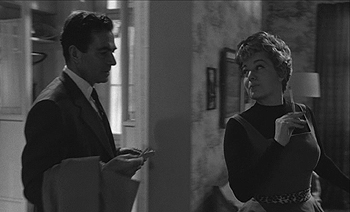 |  |
 | 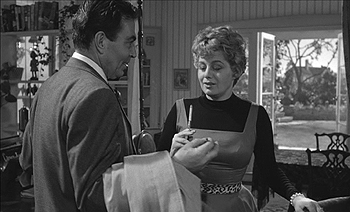 |
 | 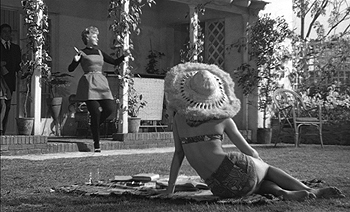 |
When we enter the living room in shot 74 we see the living room window with its large and distinctive arch that matches with what we had seen of the exterior. The camera subtly guides us, as we approach the dining room, to shift our orientation in such a way that we hazily comprehend the dining room as being adjoined to the living room to the rear, especially with our seeing through the open patio doors the large lawn, and we already have the expectation that the garden is to the rear of the house. Examining the screengrabs, it is obvious that the dining room isn't to the rear of the living room, that it is instead to the left of it, but that isn't our feeling of it and it's the feeling, the impression that Kubrick imparts with the camera that matters and defeats what we visually observe. Also, the depth of field feels flattened so there's almost no experience of the dining room except for "wall with big patio doors onto a fair size lawn and a big house beyond that." Aiding and abetting is the striped wallpaper in the dining room and a corner hutch. The left corner of the dining room disappears into the hutch and the wallpaper's stripes.
The interior of the house is a studio set. There is no reason why Kubrick should build it out so that the dining room and lawn are to the left of the living room, in conflict with the exterior, and that illusory means must be used to make the audience feel the dining room and lawn are to the rear.
Now, onto the second floor, which we expect from the exterior shot to be a full floor. The stairs and the landing are open so we have an open view up from the first floor.
The below may help in envisioning the second floor.
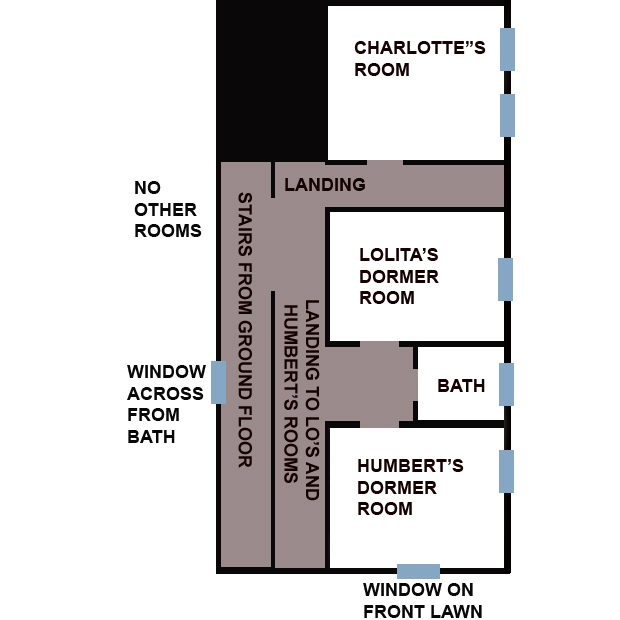
Our view of the second floor is always, up to a certain point, of the area to our right of the front door facing the house's exterior. We are never shown the area to the left.
Because we are always shown only that area where the bedrooms and bathroom are, we completely forget that there should be anything else.
This is how we usually see the bathroom on the second floor, from the landing. In shot 176, after Lolita leaves for camp, Humbert starts to go into his room and then turns and goes into Lolita's room.
Humbert starts to go into his room | Humbert goes into Lo's room opposite |
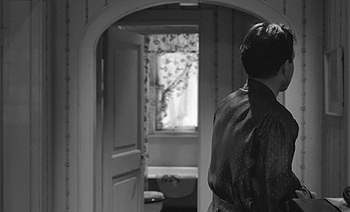 |  |
Kubrick could have left well enough alone. He could never have concretely confronted us with the absence of the rest of the second floor. And yet he chooses to show us that the other half of the second floor is not there. He does this first in shot 185, when Humbert is ducking into the bathroom to hide from Charlotte. We finally get a glimpse of the side of the house opposite the second floor landing, and we see a window, but it likely slips right past the viewer as it is a quick shot. But shot 229 is a nice long hold on Humbert with that window behind him. He and Charlotte had fought because he learned she was planning on sending Lolita away to a boarding school. Upset, Charlotte leaves the bedroom. He realizes her first husband's gun is loaded and makes up a plan for shooting her. After all, she had just told him it wasn't loaded. He will say she had told him it wasn't loaded and they were playing and it turned out to be loaded after all. Water is running in the bathtub and he believes Charlotte is taking a bath. In shot 229 he stands before the bathroom door with the gun in hand, preparing himself to shoot her. But he can't do it. He puts the gun up in his pocket.

What about that window beyond Humbert? It kind of feels like the window that is in the bathroom but it's not. It's a window hanging out there on the wall opposite the landing. It would be above the living room of all places. Above the living room! It would be looking out over the roof of the living room because there is no other half of the second floor. Because it bears a little resemblance to the window in the bathroom, just because of our previous orientations we might accept that window as being just where it should be. For instance, based on shot 176, we might "feel" that the window is just where it should be. But we are turned around. We are looking at Humbert from the bathroom rather than looking at the bathroom and we still might accept the window even though we're aware of this.
Kubrick decides to show us this impossible window while Humbert is pointing the gun at the viewer. The reveal, via the window, that there is no rest of the second floor, that what we believe and how things actually are don't match up, even takes on a confrontational edge with Harold Haze's gun, in Humbert's hand, staring us down. The same gun with which Harold was going to take his life, didn't have the opportunity, and still has a bunch of bullets in its chambers. Charlotte had just said she would likely commit suicide with that gun if it turned out Humbert didn't believe in god, and Humbert had said the question was whether or not god believed in him.
Kubrick shows us again that the other half of the second floor doesn't exist.
Humbert starts to go into Lo's room | Humbert goes into his room opposite |
 |  |
After shot 230, in which Humbert presses open the bathroom door (duplicated in room 237 in The Shining) to find that Charlotte isn't in the bath, in shot 231 he begins to go into Lo's room then turns and enters his room, Kubrick having Humbert duplicate (though now reversed) his movements in shot 176 after Lolita had left for camp. With shot 176, Humbert had begun to return to his room then turned and entered Lolita's room, where he was in near tears when he was delivered Charlotte's letter confessing her love. In shot 231, after Humbert looks in the bathroom and finds Charlotte isn't there, he does the same movement, going first to the screen right room then the screen left room, though it's backward this time around as we're facing away from the bathroom rather than facing toward it. Entering his room, he finds Charlotte reading his diary.
Kubrick also uses a window in The Shining for the undeniable, big reveal that what we believe we are seeing and how things actually are don't match up, only in The Shining he does it very early on and too creepy effect. That window on the landing, before which Humbert hesitates and reverses course, functions rather as the window in Stuart's office in The Shining, which we eerily realize is an impossible window. We know this as we were just shown, in the lobby, how Stuart's office is an interior room and should be enclosed on all sides.
The exteriors of both buildings are entirely out of sync with the interiors, and the interior of The Overlook keeps running afoul of itself. The window in Stuart's office glowers at us, "I'm impossible! I'm not right!" If we only have studied The Shining then we imagine that this has to do with "Creepy Overlook!" But Kubrick has done the same in Lolita, the big reveal window being behind Humbert as he points the gun at the viewer.
The same happens with Bill and Alice's apartment in Eyes Wide Shut. It's architecture isn't right either, which is made obvious to us several times.
It's like being absolutely unconscious of any suspension of disbelief and then Kubrick pointedly states, "Look! Look! Look! This isn't right at all! This is all illusory, flagrantly in-your-face impossible, and yet you haven't noticed it!" Why would he do this? Is he doing this? Is he just creating atmosphere? What is he up to?
Just as we have an illusory 90 degree turn happen in the living room of the Haze household that leads us to believe the lawn is out back, much the same happens at the household in Beardsley.
First, we are shown the exterior of the house in shot 367. We see rooms to left and right of the central front door.

It's likely that as you are viewing the film, when Humbert enters the front door, in shot 368, and goes to the main room, this is how you will view his path. He enters. The stairs, as with the Haze household, will be comprehended as being opposite the front door. One will think of him as going left into the main room.
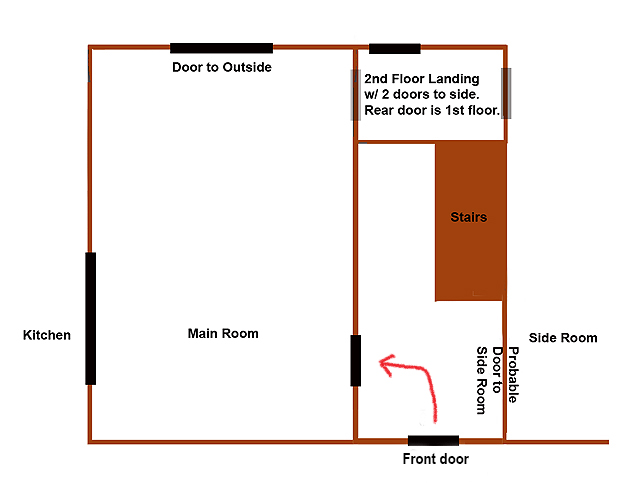
I have tested this on some people, having them draw how they envision the interior to be, without telling them what I was looking for. And they have drawn it as I expected, as in the diagram where the stairs lead from the door and Humbert turns to the left.
Let's take a closer look.
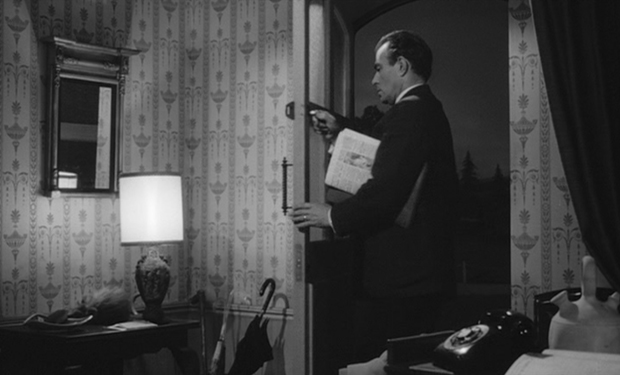
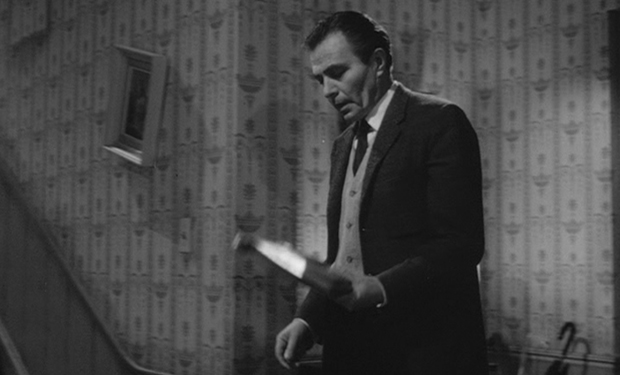
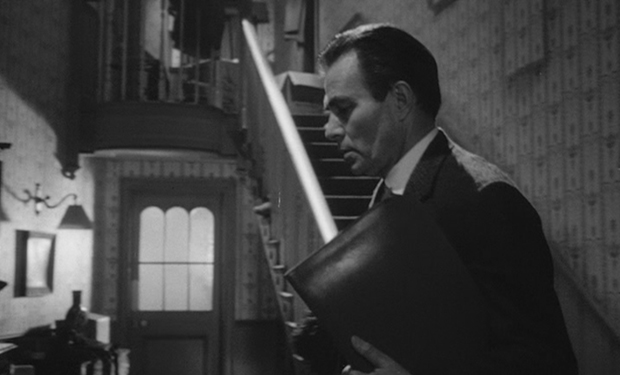
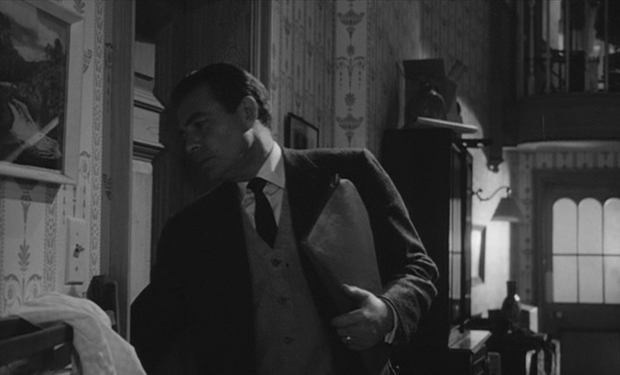
This is the actual layout. That flight of stairs is not opposite the front door. They run to the right from the front door. The exterior shot shows a room instead there, to the right of the front door, with windows. The stairs don't allow for this.
Kubrick has done again what he did with Charlotte's house. In the Haze house, you had a false 90 degree turn where the viewer felt that they passed through the living room, into a dining room to the rear of it where were patio doors that opened onto a garden at the rear of the house. We were also expecting the garden to be to the rear of the house, based on what we had observed of the exterior of the house. Instead, the dining room is to the left side of the living room and the garden to the left of that, so it is at the left of the house rather than the rear. That doesn't fit at all with the exterior of the house and so we go with that false 90 degree turn in order to force the house to fit with what we had initially viewed of the exterior.
Kubrick does the same thing here. 1) He shows the exterior of the house. We anticipate rooms to left and right of the front door because we see them. 2) He shows you then the interior, moving the camera from right to left following Humbert. He shows only a little at a time, not the whole scene, so it's very easy for you to feel a 90 degree turn has happened. One reason it happens is that one has already seen the front of the house and stairs leading up to the right flies against what one has just seen. In order to justify what one is seeing with what one expects, one may move the stairs so they are envisioned as being opposite and leading directly away from the door, as at the Haze household, and that Humbert makes a 90 degree turn to the left to enter a parlor room to the left of the front door.
An aid to our making that false 90 degree turn is that as Humbert enters we are not immediately shown the stairs that are to the left of the door. Instead, Kubrick has a little foyer area of just a couple of feet within the door so we see first the foyer wall. By the time we hit the stairs, enabled by that wall and our expectations, we are able to insert that false 90 degree turn to satisfy what we believe we should be seeing. The dark curtain that is to the right of the frame as Humbert enters the front door also helps guide us to make that 90 degree turn which never happens. It helps suck us into feeling like Humbert turns left. That is a reason why the curtain is there because it otherwise serves no purpose.
It also doesn't hurt that everything is in disarray, and that a painting is prominently askew on the wall. However, there was no disorder at the Haze household, and still Kubrick tricks the viewer.
Kubrick knows the eye. He knows expectations. He sets up situations that demand cognitive dissonance, but also guides the viewer through them in such a manner that they may not sense contradictions, or at least not until he points them out, and even then the viewer may ride over those contradictions with little or no recognition, perhaps only a needling sense of occasional disorientation. Toward what purpose is the question. The result seems to be that the on-screen expression of reality, despite its immersiveness, is always a little off-kilter in a way that goes beyond the standard and acceptable suspension of disbelief, one can't set one's feet securely down and know where everything is relative cardinal points. The audience believes they are getting a realistic story when instead they are deep in surrealistic cinema.
May 2018 extracted from analysis and expanded upon slightly.. Approx 2900 words or 6 single-spaced pages. A 22 minute read at 130 wpm.
Go to Table of Contents of the analysis (and supplemental posts)
Link to the main TOC page for all the analyses